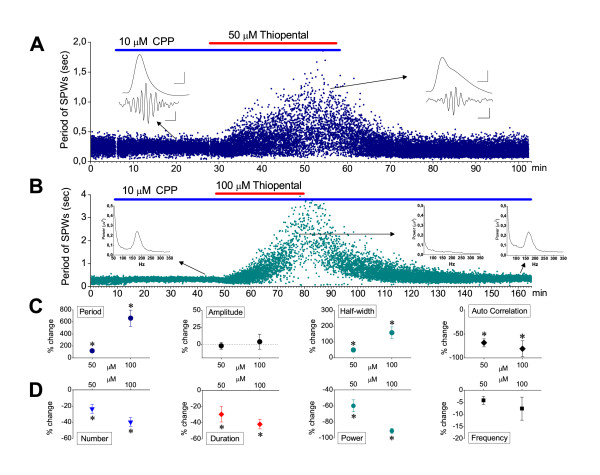Figure 6.
Thiopental action on SPW-Rs does not involve NMDA-mediated synaptic transmission. A. Representative histogram of instantaneous period of SPW-R activity recorded from the CA1 st. pyramidale. Thiopental (50 μM, red bar), applied in the presence of NMDA receptor antagonist CPP (10 μM, blue bar) produced reversible reduction in the rate of SPWs, a similar effect to that observed when the anesthetic was applied alone (compare with Fig. 3A). Inserts show examples of SPWs (traces on the top, low-pass filtered) and ripples (traces on the bottom, band-pass filtered) selected from times before and during thiopental application (arrows indicating the panel on the left and right respectively). Note that under thiopental SPWs are prolonged and ripple episode was shortened, containing decreased number of ripple waves. Calibration bars in the inserts: 50 μV, 25 ms for SPW; 25 μV, 50 ms for ripples. B. Histogram of instantaneous period of SPW-R activity recorded from the CA1 st. pyramidale of a slice which received 100 μM of thiopental (red bar) in the presence of CPP (blue bar). Inserts show the power spectra, at the ripple range, generated from epochs of 2 min taken from the different conditions (i.e. in CPP, in thiopental and after washing-out thiopental) as indicated by arrows. C-D. Collective data of the effects of thiopental on SPWs' (C) and Ripples' (D) measures in the presence of CPP. Measures of SPWs and Ripples were obtained from 9 and 7 slices respectively, at the concentration of 50 μM and from 8 and 5 slices respectively at the concentration of 100 μM. Asterisks indicate statistically significant drug effects (paired t-test, at P < 0.05). Error bars not shown were smaller than the size of the symbol.

